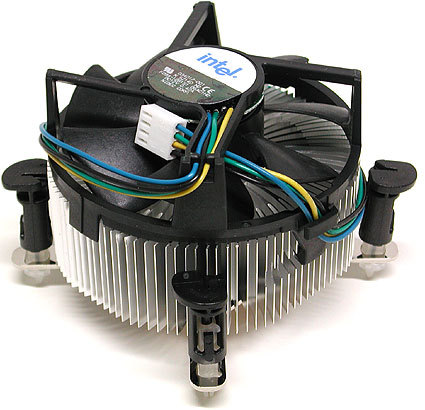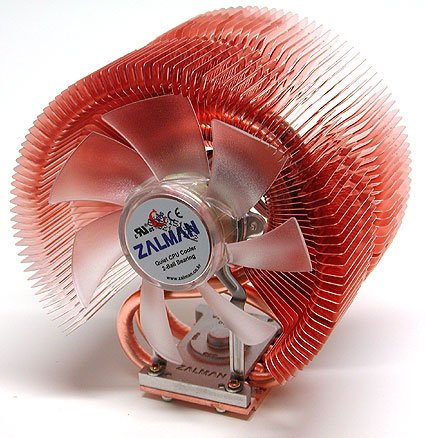A 4.1 GHz Dual Core at $130 - Can it be True?
3.33 GHz Remains Stable At Standard Voltage Levels, Continued
The cooling performance of the box cooler is barely adequate. The system starts up trouble-free at 3.33 GHz, and our overclocking causes power consumption in idle mode to climb by about 6 watts. If the CPU is heavily loaded for some time, however, the system inevitably crashes because of overheating. The cause of this turns out to be the way in which the fan is controlled - it was designed by Intel to emit only a small amount of noise while active, but because of overclocking, power consumption levels climb by 24 W and the cooler gets into trouble. The controller can't react properly to this jump in energy consumption and the fan can't increase its speed fast enough to keep the CPU from overheating. It's also no help that your only options in the BIOS are to control the fan by PWM or voltage levels, or turn it off altogether.
The box cooler only works when this CPU is run at its standard clock rate. It's not designed for overclocking use.
| Row 0 - Cell 0 | ||
| Pentium D 805 | Intel Standard CPU Cooler | |
| Clock rate | 100% utilization | Idle mode |
| 4.10 GHz | crash | crash |
| 4.00 GHz | crash | crash |
| 3.80 GHz | crash | crash |
| 3.60 GHz | crash | crash |
| 3.32 GHz | crash | 57 °C |
| 2.66 GHz | 78 °C | 53 °C |
After abandoning the Intel box cooler, we chose a Zalman model instead. We recommend the CNPS9500, one of the best coolers available on the market today.
The Zalman CNPS9500 has no difficulty handling heat levels at a CPU clock rate of 3.33 GHz.
Get Tom's Hardware's best news and in-depth reviews, straight to your inbox.
Current page: 3.33 GHz Remains Stable At Standard Voltage Levels, Continued
Prev Page 3.33 GHz Remains Stable At Standard Voltage Levels Next Page Trouble Free Operation At 3.60 GHzTom's Hardware is the leading destination for hardcore computer enthusiasts. We cover everything from processors to 3D printers, single-board computers, SSDs and high-end gaming rigs, empowering readers to make the most of the tech they love, keep up on the latest developments and buy the right gear. Our staff has more than 100 years of combined experience covering news, solving tech problems and reviewing components and systems.
-
Tnias I am quite interested in your post regarding the D 805. Considering that it is now available for around $60.00 (03/20/09), it still sounds like a steal. We just upgraded our Adobe CS2 software to the new CS4 Master Suite, which caused the need for a graphics card upgrade. We have an nVidia GeForce GTX 260, but haven't installed it because our computer is a HP Media Center PCm7350n computers each with a 2.8 GHz CPU on a ASUS P5LP-LE mobo. Your article seemed to imply that there is software available that might adjust the clock from inside windows and we are wondering if it can on that mobo or if we will have to get a different mobo. If so, we are wondering what might be our most cost effective but stable options. We are certainly going to need a new power supply for the GTX 260, which requires 525 Watts. We are looking at just putting in PC Power & Cooling’s, Silencer 610 EPS12V power supplyand letting it go at that, but we are also thinking about upgrading the CPU and mobo if necessary.Reply
Of course, we would like to keep the cost down as much as possible.
We have no idea where the best bang for the buck will be. For us a stable system is more important than blazing speed. Thus, the HP's worked fine for what we originally got them for; it’s just that our graphics and video production software are forcing upgrades in speed and power.
The D850 chip sounds incredible and the power supply we already have to get will handle overclocking that chip. It even sounds like that chip will work in the existing mobo if we can find a way to change the clock speed from inside windows instead of from the BIOS. HP BIOS does not allow adjusting the clock speed in the BIOS but can't BIOS just be changed as well; isn't it just an EPROM?
Anyway, even if we opt for changing out the mobo for another case compatible Asus mobo, we still have to answer the question of which board and chip combination will give us the most stable service for the least cost.
Any ideas that might help us plan the most appropriate upgrade and the least cost? -
amnotanoobie TniasAny ideas that might help us plan the most appropriate upgrade and the least cost?Reply
With the price of components that you need to make this run stable, and the amount of electricity that this would use, a cheap Core 2 and motherboard and DDR2 memory would cost you less in the long run.
Example:
Intel Pentium Dual Core E5200
Kingston DDR2 2x2GB 800MHz
Gigabyte G31M-ES2C
This should cost less than $200.


